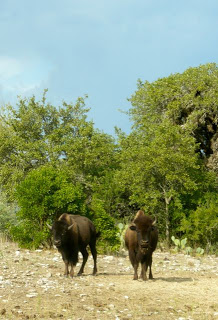Touring the Ranch
 Along the way I learn all kinds of things. The gravel roads here are white because they’re a limestone/granite blend called caliche. The ranch is over 1500 acres and the buffalo herd is at 43 this year (including 8 calves). The next “harvest date” for two of the adult “buffies,” as they’re sometimes called, is October 24th. When I ask R if he likes to call them bison, buffalo, or buffies, he responds: “Sometimes I call them sons ‘a bitches, depending on what they’re doing. You have to treat them like a wild animal because they can and will turn on you at any instant. One thing I have learned,” he leans in, “is that if you ever see their tails curl up into a question mark, you’re in for it. It’s bad. It’s real bad.”
Along the way I learn all kinds of things. The gravel roads here are white because they’re a limestone/granite blend called caliche. The ranch is over 1500 acres and the buffalo herd is at 43 this year (including 8 calves). The next “harvest date” for two of the adult “buffies,” as they’re sometimes called, is October 24th. When I ask R if he likes to call them bison, buffalo, or buffies, he responds: “Sometimes I call them sons ‘a bitches, depending on what they’re doing. You have to treat them like a wild animal because they can and will turn on you at any instant. One thing I have learned,” he leans in, “is that if you ever see their tails curl up into a question mark, you’re in for it. It’s bad. It’s real bad.”As for the deer I’ve been seeing, only the white-tailed deer are native. The fallow, sikia, axis, and aoudad (spelling?) are all “exotic” and, according to R, ” They’re like dogs. You drive down the road and they’ll follow your truck.” And the prickly pear cactus I’ve been seeing with “white speckles” are actually infested with bugs (called cochineal?). If you squish one of the speckles between thumb and forefinger, the white suddenly turns to blood-red liquid that was used back in the day by Comanches for war paint.
“[A] lush, diverse mat covered all but the steepest, rockiest hills and protected the soil it had built over ages, dotted with live oaks here and there, a savanna. But an excess of cattle ate it down and destroyed it, and the soil lay exposed to erosion, and what ages had built a few decades sufficed to undo. The original tall grasses show up [in Texas Hill Country] now only in occasional clumps and patches, and on the hillsides lie rough pieces of chunk rock, once partly or wholly buried beneath rich earth whose organisms slowly ate on them…
“…I suppose it would be easy enough to wax prim about this, in our hindsight aftertime. But the pattern that predestined the Hill Country’s exhaustion was an ancient one, not just American but human. Virgin land has intoxicated herders and farmers since whenever such activities began, and has seduced them into believing its lushness would last forever, and they have used it hard. Even in easily despoiled parts of the world like these hills, the land’s decline under such treatment, though rapid in geological or merely historical terms, has usually been gradual enough that men could lull themselves into not seeing it until too late. And if indeed they saw it, they were themselves often stuck in the pattern too–through habit, through the disappearance of frontiers. Hence the bared hills of Texas and Lebanon and Greece, and the starkness of much once-fertile Spain and of those Balkans that were the Romans’ granary, and the lateritic desolation of cleared tropical rainforest lands, and the sad decline of practically all vulnerable parts of the whole poor bloody old earth, whose virginity no longer exists simply because one of its millions of biological experiments developed a conquering brain, and hands.”
Cowboy Fact of the Day: The second most common cause of death for cowboys was pneumonia.





